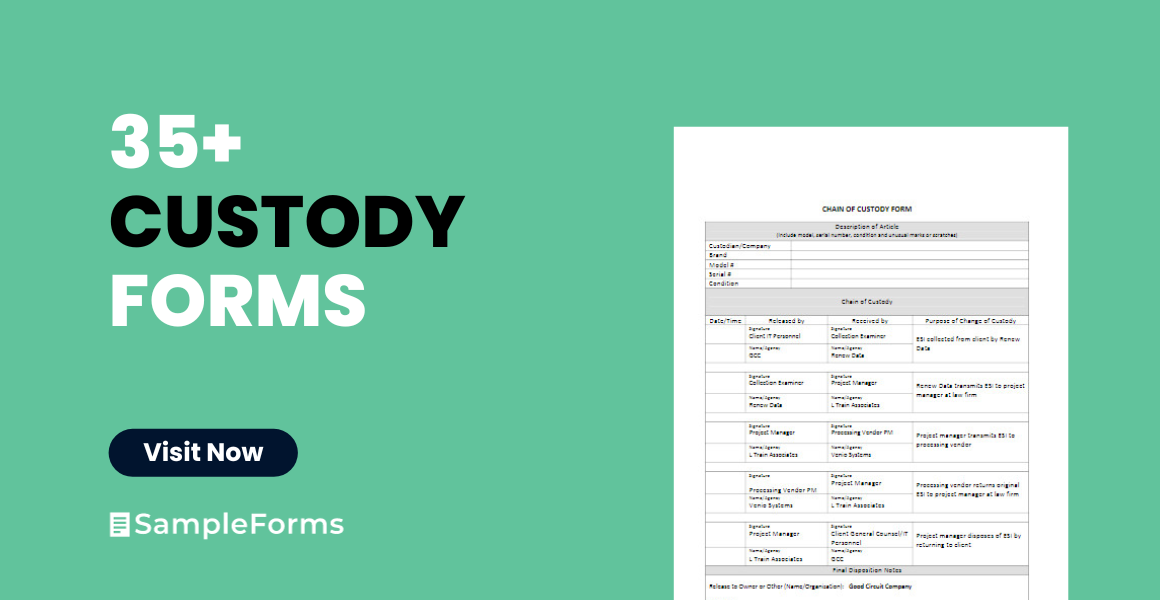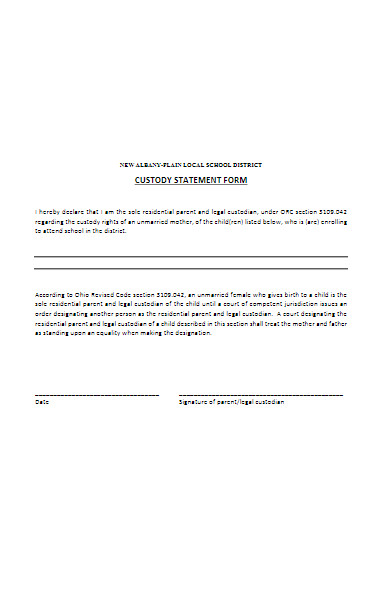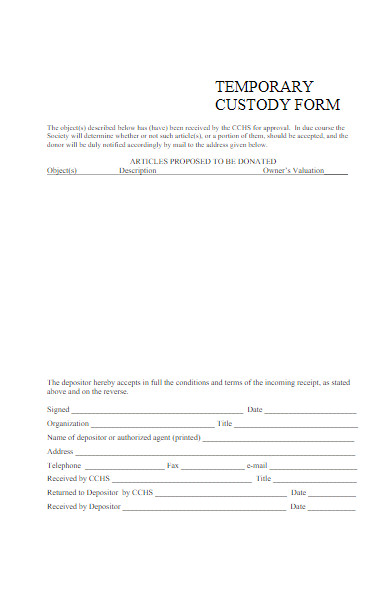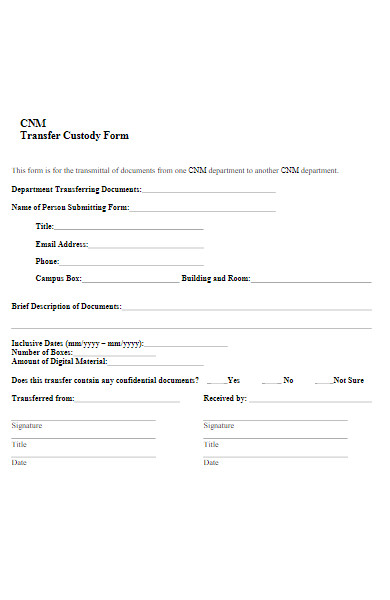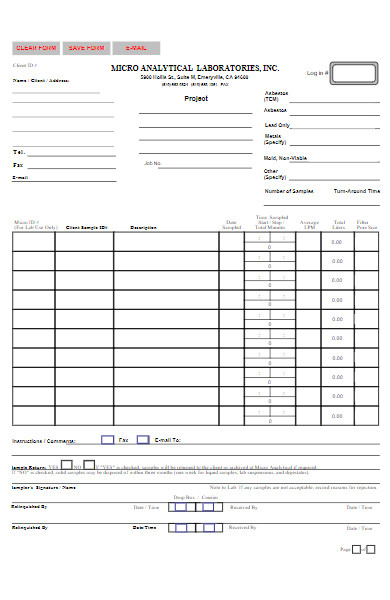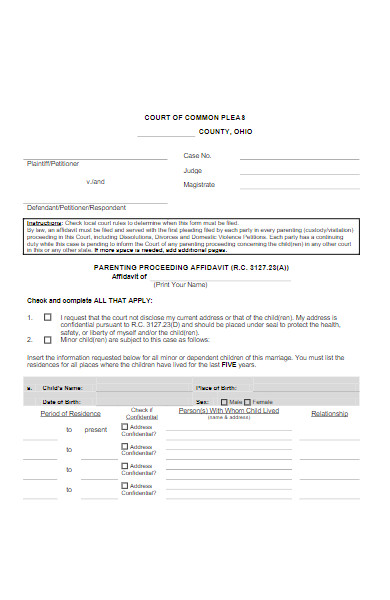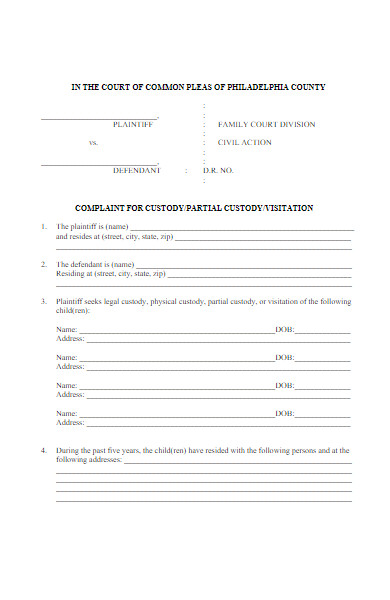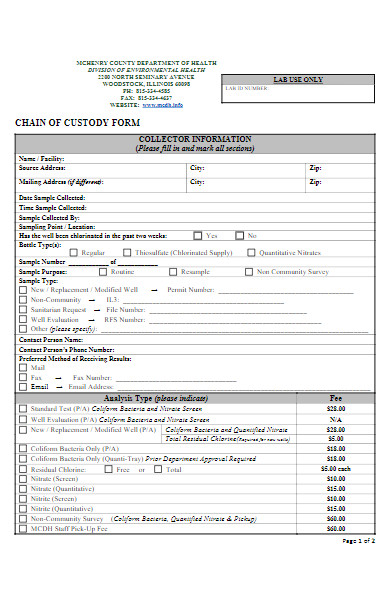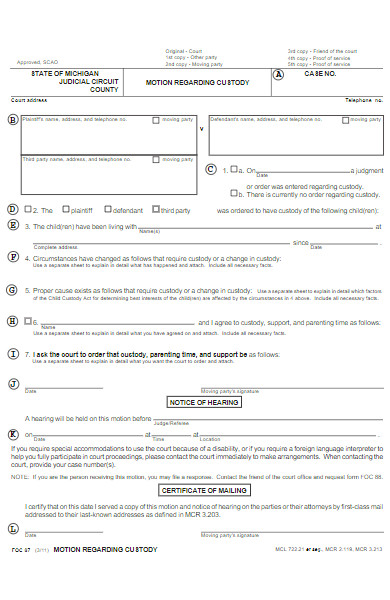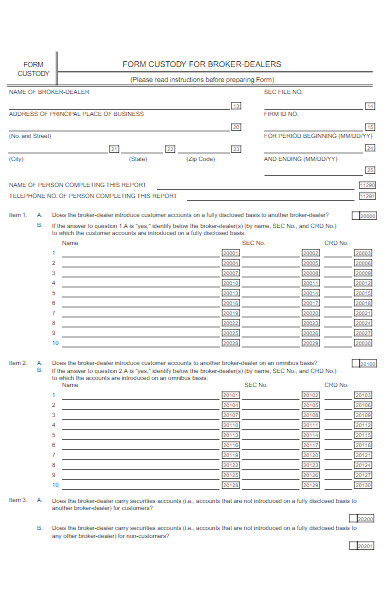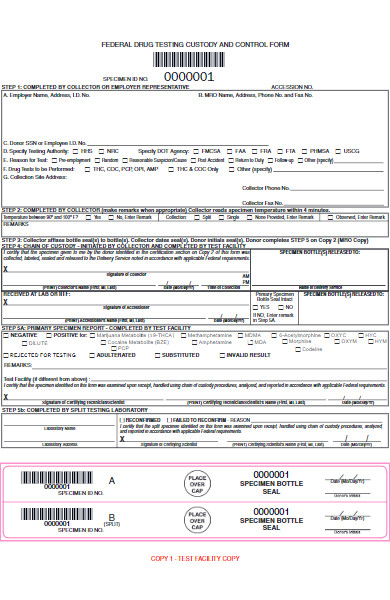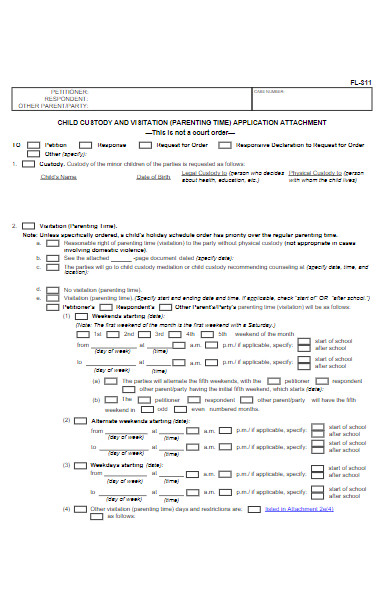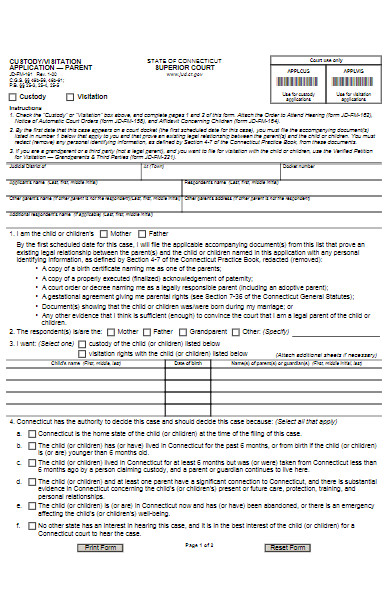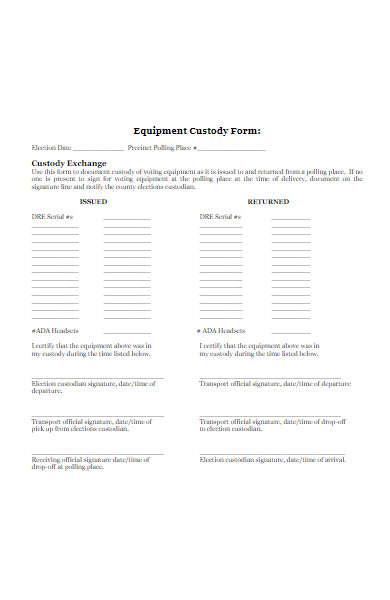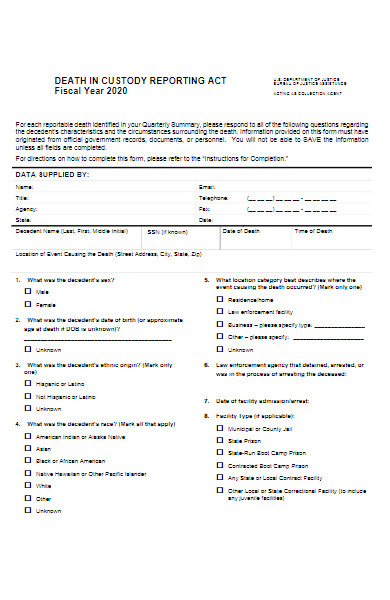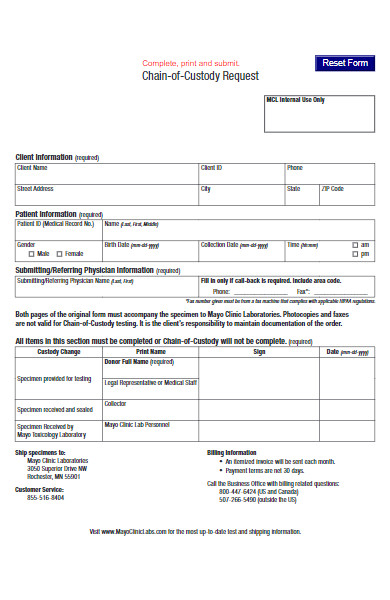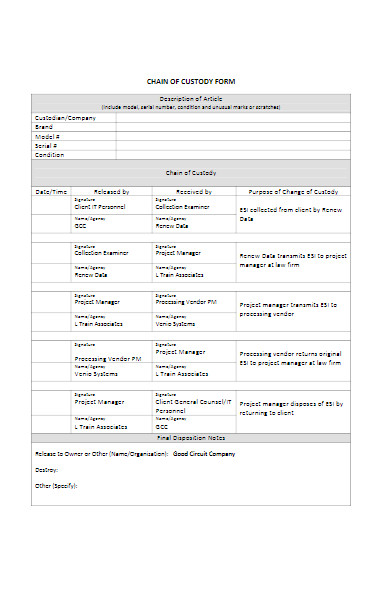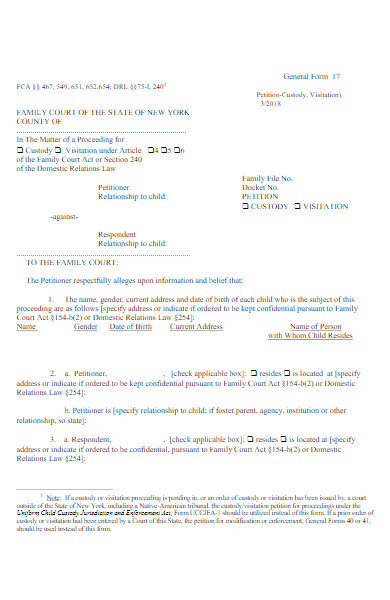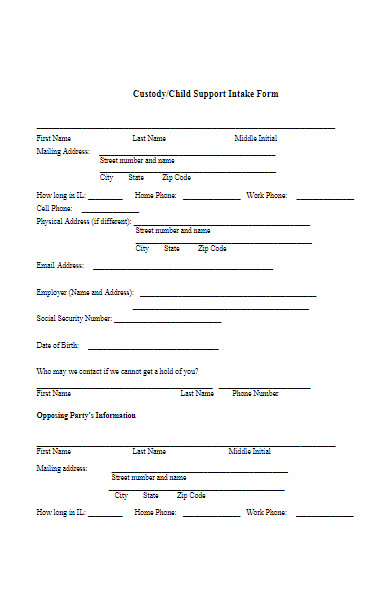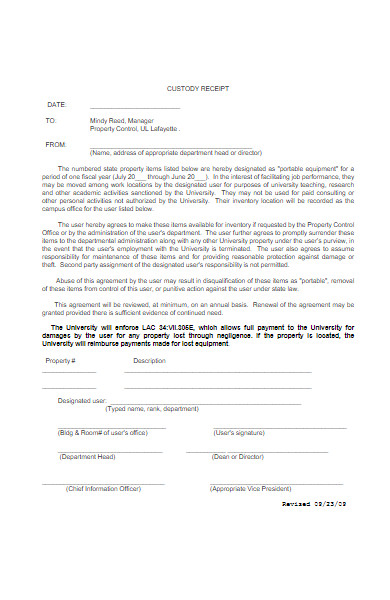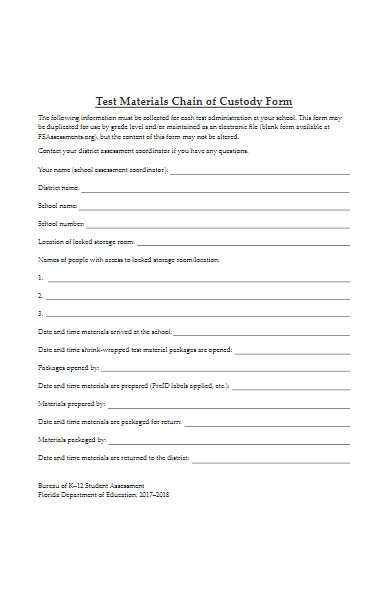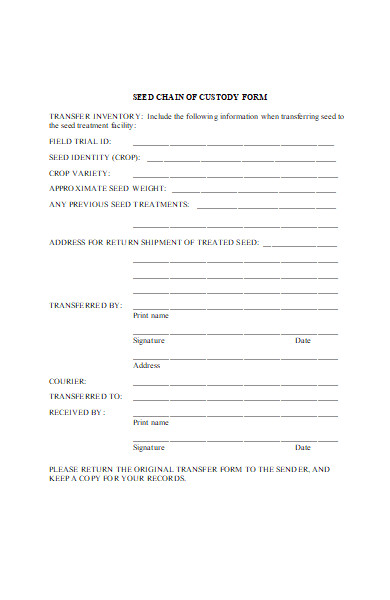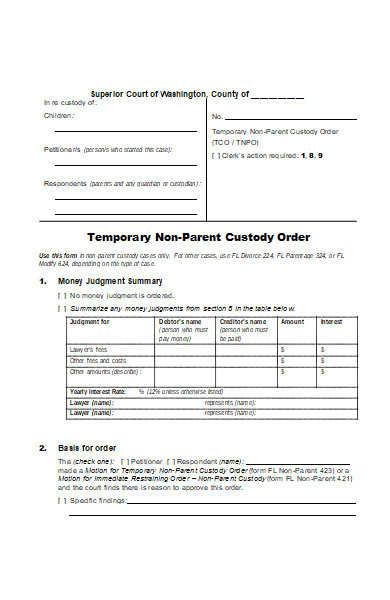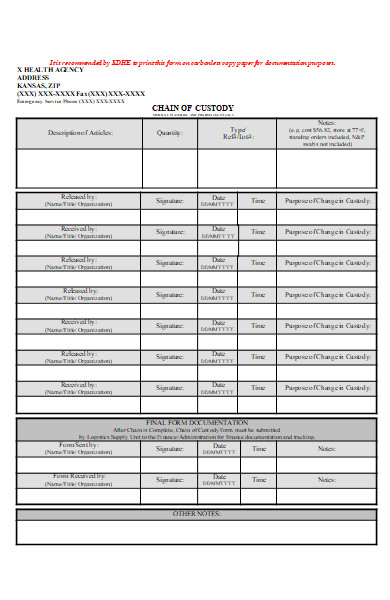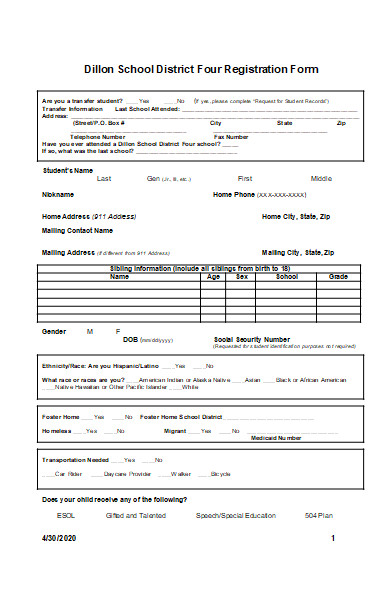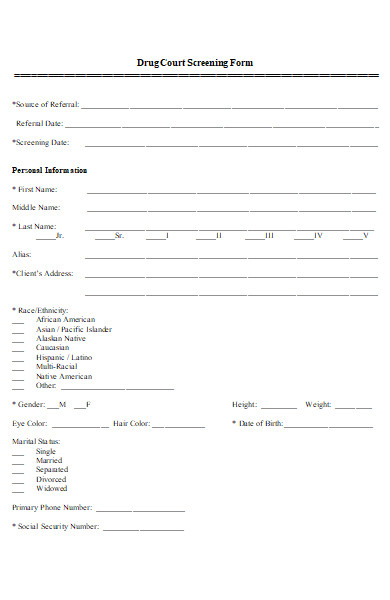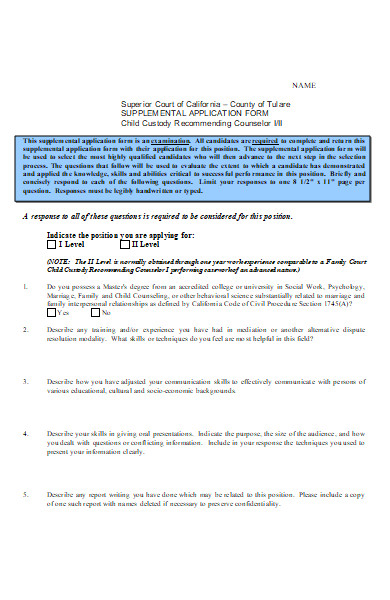Navigating the intricacies of child custody can be daunting. At the heart of the process lies the Custody Form, an essential tool designed to formalize decisions regarding a child’s living arrangements and the parental rights and responsibilities. This document can range in complexity, from simple agreements form to intricate legal decrees. Delving into its meaning, various types, notable examples, and crafting methods, along with expert tips, can illuminate the path for parents and guardians navigating these often emotional waters.
What is a Custody Form ? – Definition
A Custody Form is a legal document that outlines the rights and responsibilities of parents or guardians concerning the care, control, and maintenance of a child or children following a separation or divorce. These printable form defines the type of custody granted (e.g., joint, sole, physical, or legal) and specifies the terms of visitation, decision-making responsibilities, and other pertinent details. It serves as a formal agreement or court order, ensuring the child’s best interests are prioritized and upheld.
What is the Meaning of a Custody Form?
The meaning of a Custody Form revolves around the legal delineation of responsibilities and rights of parents or guardians concerning their child or children. It serves as an official record that details how custody is to be shared or designated, encompassing facets like where the child will reside, how decisions about the child’s upbringing will be made, and the nature and schedule of visitation rights. Essentially, these fillable form is a tangible representation of the agreed-upon or court-decided terms ensuring the child’s welfare and stability in the aftermath of parental separation or divorce.
What is the Best Sample Custody Form?
The best sample custody form can vary based on jurisdiction, specific needs, and the unique circumstances of the parents and child involved. However, a comprehensive custody form typically contains the following sections:
- Parties Involved: Full names of both parents or guardians and their contact details.
- Child’s Details: Full name, date of birth, and other relevant information of the child or children involved.
- Type of Custody:
- Physical Custody: Determines where the child will reside. It can be joint (shared between both parents) or sole (with one parent).
- Legal Custody: Refers to the right and responsibility to make decisions about the child’s upbringing, including education, health, and religion. Again, this can be joint or sole.
- Visitation Schedule: Details about when and how the non-custodial parent will spend time with the child. This could include weekdays, weekends, holidays, and vacations.
- Decision-making Protocols: Procedures for making significant decisions about the child’s education, health care, extracurricular activities, etc.
- Child Support: Details about financial support for the child, including the amount, frequency, and method of payment.
- Communication Protocols: Guidelines on how parents will communicate with each other and with the child.
- Dispute Resolution: Procedures for resolving disagreements that might arise concerning the child’s upbringing.
- Modification Clauses: Conditions under which the custody arrangement can be reviewed or modified.
- Additional Provisions: Any other specific details or stipulations agreed upon by both parties, such as protocols for introducing significant others to the child.
- Signatures: Both parents or guardians sign the form, indicating their agreement to its terms.
- Notary Acknowledgment: Some jurisdictions may require the form to be notarized to affirm its authenticity.
If you’re seeking an actual sample blank form, it’s best to consult legal resources in your jurisdiction or consult with an attorney specializing in family law. They can provide appropriate templates or forms tailored to your situation and local regulations.
FREE 35+ Custody Forms
How does a Custody Form affect child support agreements?
A Custody Form, which details the custody arrangement for a child or children between parents, can significantly influence child support agreements. Here’s how:
- Determination of Obligation: The parent who does not have primary physical custody (often referred to as the non-custodial parent) is typically the one responsible for paying child support to the parent with primary custody. This is to ensure that both parents are contributing to the child’s financial well-being.
- Amount of Support: The amount of child support is influenced by the custody arrangement. For instance, in joint or shared custody situations where the child spends an almost equal amount of time with both parents, the child support amount might be reduced or adjusted because both parents are directly incurring expenses for the child’s care.
- Calculation Factors: Child support calculations consider various factors, such as the income of both parents, the number of children, and the specific needs of the children. However, the custody arrangement remains a significant factor. In many jurisdictions, guidelines or formulas are used to calculate child support, and the amount of time a child spends with each parent is a critical variable in that formula.
- Modifications: Changes in the custody arrangement, such as a non-custodial parent becoming the primary custodial parent, can lead to revisions in child support obligations. It may result in a reversal of who pays or an adjustment in the amount.
- Additional Expenses: A Custody Form might also detail how other child-related expenses, not covered by the regular child support payment, will be handled. This could include costs for education, medical care, extracurricular activities, and travel. The agreement might stipulate that certain expenses be split equally, proportionally based on income, or handled in some other manner.
- Enforcement and Compliance: The details outlined in the Custody Form can be used as a reference when ensuring that child support payments are made in accordance with the agreement. If disputes arise, the terms of the custody agreement can be essential in court proceedings.
- Interplay with Legal Custody: Child support is typically related to physical custody (where the child lives), but legal custody (decision-making authority) can play a role. For instance, if one parent has sole legal custody and makes a decision that leads to additional expenses, the question of who bears that cost can be complex.
It’s essential to consult with a family law attorney or legal professional when determining child support in conjunction with sample custody agreements form, as laws and regulations vary by jurisdiction. They can provide guidance tailored to individual circumstances and local regulations.
How do I make a chain of Custody Form?
Creating a Chain of Custody (CoC) Form is crucial for ensuring the integrity and security of samples or evidence. A comprehensive CoC Form should provide a complete and unbroken record of the possession, handling, and location of a sample or piece of evidence from the time of its collection to its final disposition. Here’s a step-by-step guide to creating one:
-
Header Information:
- Title: Clearly label the document as “Chain of Custody Form.”
- Case or Project Number: To easily identify and link the CoC form to a specific case or project.
- Sample/Evidence ID: A unique identifier for the sample or evidence.
- Date and Time of Collection: When the sample or evidence was originally collected.
-
Description of the Sample/Evidence:
- Type of sample (e.g., blood, soil, electronic device)
- Quantity
- Collection method
- Any special storage or handling requirements (e.g., refrigeration, anti-static bag)
-
Collection Details:
- Name of the person collecting the sample/evidence
- Signature of the collector
- Location of collection
- Purpose of collection (e.g., suspected drug sample, environmental testing)
-
Transfer of Custody Section:
- This section will have multiple rows and will record every transfer of the sample/evidence. For each transfer, the following columns should be present:
- Date and Time of Transfer
- Transferred From (Name and Signature)
- Transferred To (Name and Signature)
- Purpose of Transfer (e.g., analysis, storage, further evidence collection)
- Location/Department (where it’s being transferred to, such as a particular lab or evidence room)
- This section will have multiple rows and will record every transfer of the sample/evidence. For each transfer, the following columns should be present:
-
Storage and Transportation Details:
- Storage conditions (e.g., temperature, specific equipment like a safe or fridge)
- Transportation conditions (if applicable)
-
Analysis or Testing Details (if applicable):
- Type of analysis/test performed
- Date of analysis/test
- Results or reference to result documents
- Analyst’s name and signature
-
Final Disposition:
- Date and time
- Method (e.g., returned to owner, destroyed, archived)
- Name and signature of the person responsible for the final disposition
-
Additional Notes Section:
- For any other relevant details or unusual occurrences.
-
Footer:
- Page numbers (especially if your form spans multiple pages, e.g., “Page 1 of 3”)
After drafting your Chain of Custody Form, it’s advisable to have it reviewed by legal or professional personnel familiar with the specific requirements of your field or jurisdiction to ensure its thoroughness and compliance. Always ensure that the form is filled out legibly and stored securely to maintain the integrity of the record. You also browse our Custody Agreement Forms.
Do you need a chain of custody form?
Whether you need a Chain of Custody (CoC) form depends on the context in which you’re working and the requirements of that specific situation. A CoC form is crucial in various scenarios where the integrity and security of a specific item or sample need to be maintained and proven. Here are some contexts where a CoC form is often necessary:
-
Legal and Forensic Settings:
- Evidence: When evidence is collected at a crime scene or during an investigation, its integrity must be maintained for it to be admissible in court. A break in the chain of custody can render evidence inadmissible or its reliability questioned.
- Drug Testing: For example, in workplace drug testing scenarios, a proper chain of custody ensures that samples have not been tampered with or mixed up.
-
Environmental Sampling:
- When environmental professionals take samples (soil, water, air), the CoC form ensures that the samples were handled correctly and prevents any allegations of tampering or contamination.
-
Medical and Laboratory Settings:
- Ensuring that medical specimens are handled properly, especially if they are used for critical diagnoses or are part of a research study.
-
Art and Valuables Transportation:
- When transporting artworks or valuables, a CoC can assure all parties that the item has been handled correctly and not subjected to potential damaging conditions or unauthorized access.
-
Data and Electronic Devices:
- When handling electronic evidence, such as computer hard drives or mobile devices in investigations, a CoC ensures that the data was not tampered with and maintains its integrity for legal proceedings.
-
Document Transfer and Archiving:
- In some contexts, especially with historically significant or legal documents, a CoC ensures that the document’s provenance is maintained.
-
Research Settings:
- When samples are used in research, especially in clinical trials or studies that may affect public policy, maintaining a clear CoC is essential to uphold the study’s integrity.
If you are uncertain whether a CoC form is necessary for your specific situation, it’s a good idea to err on the side of caution and use one. If the integrity of an item or sample may be questioned in the future, a CoC form provides a clear record of its handling. When in doubt, consult with a legal or professional expert in the specific field or jurisdiction to get clarity on the requirements. You should also take a look at our Marriage Agreement Forms.
How do I obtain a Custody Form for my child?
Obtaining a child custody form is a step towards establishing a legal child custody arrangement. The specific process can vary based on your jurisdiction, but the following general steps should guide you:
- Determine Your Jurisdiction: Child custody matters are typically handled at the state or regional level. Thus, you’ll need to obtain forms specific to your state or country.
- Visit the Local Courthouse or Legal Aid Office: Most local courthouses have a family law department where you can obtain the necessary custody forms. Additionally, legal aid offices often provide these forms and can offer assistance in filling them out.
- State or Regional Websites: Many government websites offer downloadable custody forms. Search for your state’s or region’s official government or judiciary website. There might be a specific section dedicated to family law or child custody.
- Online Legal Services: There are numerous online platforms and services that provide state-specific legal forms, including child custody forms. Sites like LegalZoom, Rocket Lawyer, or specific state law resource websites may offer these forms, sometimes for a fee.
- Consult an Attorney: If you’re uncertain about the process or want to ensure that you’re using the correct form and filling it out accurately, consulting a family law attorney is advisable. They can provide you with the right forms and guide you on how to complete them. This step is especially crucial if you anticipate a contested custody battle.
- Fill Out the Form: Once you’ve obtained the custody form, fill it out thoroughly. You’ll typically need to provide details about both parents, the child(ren), the desired custody arrangement, and any other pertinent information.
- Filing the Form: After filling out the form, you’ll need to file it with the appropriate court. There might be a filing fee, depending on your jurisdiction.
- Await a Court Date: Once the form is filed, the court will set a date for a custody hearing. Both parents will have the opportunity to present their case. It’s highly recommended to have legal representation, especially if the custody situation is complex or contentious.
- Follow Any Additional Legal Steps: Depending on your jurisdiction and situation, there might be additional steps, such as attending mediation or parenting classes.
Remember, each state or country may have different procedures, forms, and requirements. Always consult with legal counsel in your jurisdiction to ensure you’re following the appropriate steps.
Where can I find a free Custody Form template?
If you’re looking for a free custody form template, there are several places you can check. However, it’s essential to ensure that the form you choose is appropriate for your jurisdiction and specific circumstances. Here are some general resources where you might find free custody form templates:
- State or Regional Government Websites: Many government websites, especially those associated with the judiciary, provide free downloadable legal forms, including custody forms. For U.S. residents, you can typically find these forms on your specific state’s official government or judiciary website.
- Local Courthouses: The family law division of many courthouses provides free custody forms. You can visit the clerk’s office to request them.
- Legal Aid Offices: If you qualify, legal aid societies or similar nonprofit organizations can provide you with free legal forms and might also offer assistance in filling them out.
- Online Legal Directories: Websites like FindLaw or Nolo often have directories of free legal forms, including those related to child custody.
- University Law Schools: Some universities with law programs offer legal clinics that provide resources to the public. They might have custody forms available and can also offer guidance on how to fill them out.
- Online Communities and Forums: Websites like Reddit or other legal forums sometimes share resources, including form templates. However, exercise caution and ensure any form you use from such sources is accurate and suitable for your needs.
- Public Libraries: Some public libraries have legal resources sections with books that contain templates for various legal forms, including custody forms.
- Online Document Repositories: Websites like Docstoc, Scribd, or SlideShare might have user-uploaded custody form templates. Again, be cautious and ensure these are accurate and up-to-date.
Remember, while these resources can be a great starting point, it’s crucial to ensure that any form you use meets the specific requirements of your jurisdiction. If in doubt, consult with a local attorney or legal expert. Using an incorrect or outdated form can lead to complications in your custody proceedings. Our Domestic settlement agreement contract forms is also worth a look at
Do I need a lawyer to fill out a Custody Form?
No, you do not necessarily need a lawyer to fill out a custody form. Many individuals choose to represent themselves in family court matters, a practice known as “pro se” representation. However, there are some important considerations to keep in mind:
- Complexity of the Case: If the custody situation is straightforward, with both parties in agreement, you might feel comfortable filling out the custody form on your own. However, if there’s contention or if complex issues are involved (such as interstate or international custody matters), it might be advisable to seek legal counsel.
- Legal Nuances: Legal documents, including custody forms, can contain language or requirements that laypersons might find challenging to understand. Misunderstanding or misrepresenting information on the form can lead to complications or unfavorable outcomes.
- Rights and Responsibilities: It’s essential to understand your rights and responsibilities in a custody case fully. An attorney can provide clarity on these matters and ensure that your interests are effectively represented.
- Filing and Procedures: Along with filling out the form, there are procedures for filing it and subsequent steps in the legal process. An attorney can guide you through this process, ensuring that you meet all deadlines and requirements.
- Advocacy in Court: If your custody case goes to court, having an attorney can be invaluable. They can present evidence, cross-examine witnesses, and argue on your behalf. Even if you fill out the form on your own, you might consider retaining an attorney for the court proceedings.
- Access to Resources: Attorneys often have access to resources, such as child custody evaluators, therapists, or other professionals, which can be useful in making a case.
While it’s not a requirement to have a lawyer, many people find it beneficial, especially if they’re unfamiliar with the legal system or if the custody situation is contentious. If hiring an attorney is a financial concern, consider looking into legal aid organizations, pro bono services, or law school clinics that might offer reduced-cost or free legal services. In addition, you should review our Event Agreement Form.
How do I modify an existing Custody Form?
Modifying an existing custody order typically requires a formal legal process to ensure the new arrangement is recognized by the court and enforceable. Here’s a general overview of the steps to modify an existing custody form or order:
- Determine Grounds for Modification: Before seeking a modification, you’ll need to determine if there are valid grounds for the change. Courts usually require a significant change in circumstances since the original order. Such changes might include relocation, a change in the child’s needs, or evidence that the current arrangement isn’t in the child’s best interests.
- Obtain the Necessary Forms: Visit your local courthouse or the court’s website to obtain the forms required to request a custody modification. These forms may be labeled something like “Petition for Modification of Custody Order” or similar.
- Complete the Forms: Fill out the forms with all necessary information. Clearly state the reasons you believe a modification is necessary and provide any evidence or documentation that supports your claims.
- File the Forms with the Court: Submit the completed forms to the same court that issued the original custody order. You’ll likely need to pay a filing fee unless you qualify for a waiver.
- Serve the Other Parent: The other parent needs to be formally notified of the request for modification. This usually involves serving them with a copy of the filed documents, often via a process server or law enforcement officer.
- Attend Mediation or Parenting Classes (if required): Some jurisdictions require parents to attend mediation or parenting classes before a court hearing, especially if the modification is contested.
- Prepare for the Hearing: If the modification is contested, you’ll need to present your case at a hearing. Gather any evidence, line up witnesses, and consider consulting with an attorney.
- Attend the Court Hearing: At the hearing, both parties will have the opportunity to present their case. The judge will consider the evidence and arguments and make a decision based on the child’s best interests.
- Receive the Modified Order: If the judge approves the modification, you’ll receive a new custody order. Both parties are legally required to adhere to this modified order.
- Review and Comply: Ensure you understand the terms of the modified order and comply fully. Non-compliance can result in legal penalties.
It’s crucial to remember that this is a general overview, and the exact process may vary depending on your jurisdiction and specific circumstances. Always consult with a local attorney or legal expert when considering a custody modification to ensure you follow the correct procedures and maximize your chances of a favorable outcome.
How to Create a Custody Form?
Creating a custody form is a crucial process that requires careful attention to detail, as it outlines the rights and responsibilities of each parent concerning the child’s upbringing. If you’re drafting a custody form, follow this step-by-step guide to ensure comprehensiveness and clarity:
-
Title and Introduction:
- Begin with a clear title such as “Child Custody Agreement.”
- Mention the names of both parents and the child(ren) involved, along with relevant dates of birth.
-
Determine Type of Custody:
- Physical Custody: Decide if one parent will have sole physical custody or if it will be joint.
- Legal Custody: This pertains to making significant decisions about the child’s upbringing, such as education, medical care, and religion. Decide if one or both parents will have this authority.
-
Custody Schedule:
- Detail a clear custody schedule. Specify days of the week or month that the child will spend with each parent.
- Mention any specifics about holidays, birthdays, or school vacations.
- Outline provisions for any changes to the schedule, such as for travel or special occasions.
-
Pick-up and Drop-off Details:
- Specify locations, times, and any other pertinent details.
- Decide how transportation responsibilities will be shared.
-
Provisions for Communication:
- Determine how and when the child can communicate with the non-custodial parent.
- Decide on the methods of communication (phone, video chat, etc.) and the frequency.
-
Decision-making Protocol:
- If sharing joint legal custody, outline how decisions will be made.
- Decide on a method for resolving disagreements, such as mediation.
-
Provisions for Relocation:
- If one parent wishes to move, set a distance limit or specify how much advance notice is required.
-
Financial Responsibilities:
- Determine child support arrangements, if applicable.
- Specify who will cover health insurance, school fees, extracurricular activities, and other expenses.
-
Other Considerations:
- Outline guidelines for introducing new romantic partners to the child.
- Specify any other unique arrangements or stipulations both parents agree on, such as religious upbringing or education choices.
-
Dispute Resolution:
- Include a clause on how disputes regarding the agreement will be resolved, whether through mediation, arbitration, or court intervention.
-
Review by Legal Counsel:
- It’s essential to have the custody form reviewed by an attorney to ensure it’s legally sound and adheres to local regulations.
-
Signatures:
- Both parents should sign and date the form, preferably in the presence of a notary public to add legal weight to the document.
-
Filing:
- Depending on your jurisdiction, you may need to file the custody form with a local court to make it legally binding.
Remember, this guide provides a general overview, and custody laws can vary greatly depending on your jurisdiction. It’s always recommended to seek legal advice or assistance when creating a custody form to ensure it’s comprehensive and enforceable.
Tips for creating an Effective Custody Form
When creating a custody form, its effectiveness hinges on clarity, comprehensiveness, and fairness. Here are some key tips to help ensure your custody form is both effective and amicable:
- Prioritize the Child’s Best Interests: Always keep the child’s well-being, safety, and emotional health as the top priority when making decisions.
- Be Specific: Vague terms can lead to misinterpretations. Specify dates, times, locations, and any other details pertinent to custody arrangements.
- Stay Flexible: While it’s crucial to have a clear plan, also build in a degree of flexibility to accommodate unexpected changes and events.
- Open Communication: Foster open lines of communication between both parties. Address how disagreements or changes to the plan will be handled.
- Consider External Factors: Consider the child’s school schedule, holidays, extracurricular activities, and any other significant commitments when drafting the form.
- Include Provisions for Changes: As children grow, their needs and schedules change. Include provisions for periodic reviews or modifications to the agreement.
- Avoid Negative Language: Stay neutral and avoid using accusatory or negative language. This promotes a more amicable co-parenting relationship.
- Outline Financial Responsibilities: Clearly delineate who is responsible for what costs, including education, healthcare, extracurriculars, and other child-related expenses.
- Consider Mediation: If both parties find it challenging to agree, consider mediation. A neutral third party can provide guidance and help reach a fair agreement.
- Include Dispute Resolution Methods: Specify a process for addressing and resolving disputes, whether through mediation, arbitration, or court intervention.
- Seek Legal Counsel: Before finalizing the form, have it reviewed by a lawyer familiar with family law in your jurisdiction. This ensures its legality and enforceability.
- Maintain Privacy: Handle the document with confidentiality. Avoid sharing its specifics unnecessarily, as it contains sensitive family information.
- Document Everything: Keep records of any agreed-upon changes, disputes, and resolutions. This can be invaluable in case of future disagreements or legal challenges.
- Stay Updated: Familiarize yourself with local laws and regulations. Custody laws can evolve, and staying updated ensures your form remains compliant.
- Stay Child-Centered: While it’s essential to address parental concerns, the primary focus should remain on what’s best for the child. Whenever making decisions, revert back to this central principle.
By adhering to these tips, you can craft a custody form that addresses the needs and concerns of all involved parties while prioritizing the best interests of the child.
A custody form is a pivotal legal document outlining the rights and responsibilities of guardians regarding child care. Covering various types, including chain-of-custody and child custody forms, it ensures clarity in guardianship arrangements. Proper creation requires a blend of precision, comprehension, and consideration for the child’s best interests. Utilizing templates or legal guidance can simplify this process, making co-parenting structured and amicable. You may also be interested in our Postnuptial Agreement Form.
Related Posts
FREE 9+ Sample Legal Guardianship Forms in PDF MS Word
FREE 30+ Income Statement Forms in PDF MS Word
FREE 52+ Tracking Forms in PDF MS Word | Excel
FREE 9+ Sample Child Support Agreement Forms in PDF MS Word
FREE 8+ Child Support Agreement Forms in PDF MS Word
FREE 8+ Sample Consignment Contract Forms in PDF MS Word
FREE 5+ Sample Divorce Application Forms in PDF MS Word
FREE 11+ Separation Agreement Form Samples in PDF MS Word
FREE 5+ Testimonial Affidavit Forms in PDF
FREE 9+ Sample Consignment Agreement Forms in PDF MS Word
FREE 6+ Sample Character Reference Letters in PDF MS Word
FREE 9+ Custody Agreement Forms in PDF MS Word
FREE 8+ Sample Custody Agreement Forms in PDF MS Word
When to Sign a Temporary Guardianship Form? [ With Samples ]
FREE 17+ Sample Divorce Forms in PDF MS Word
